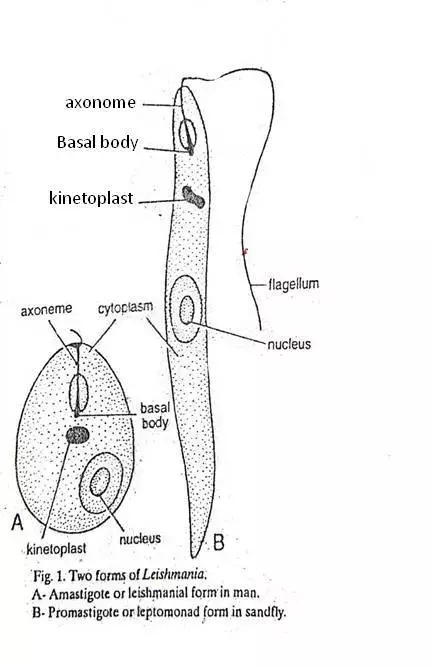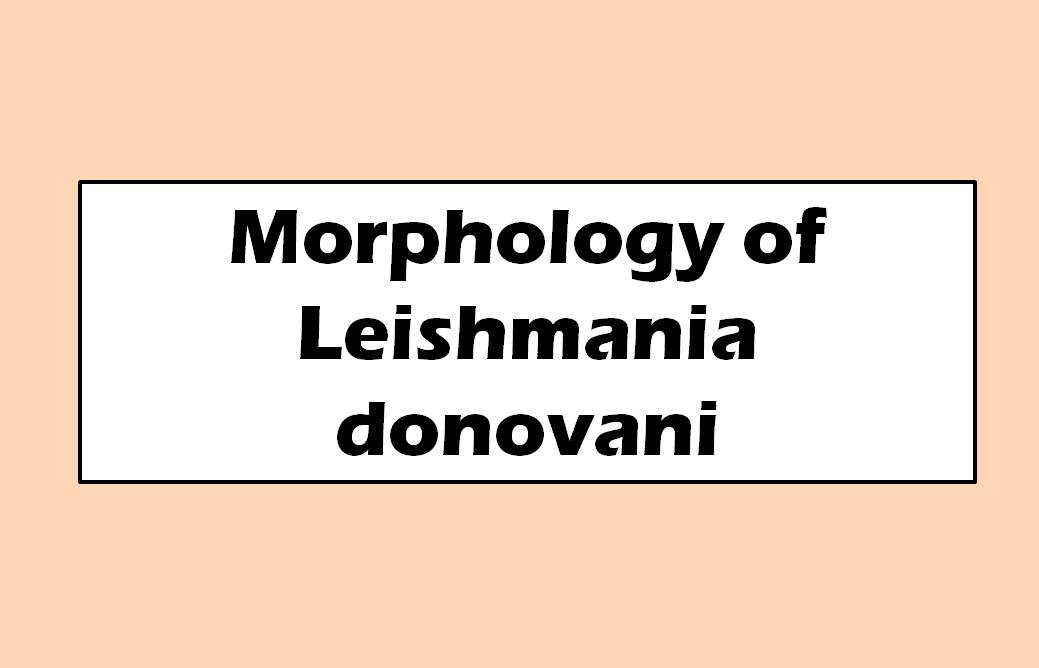In this article, we will learn the morphology or structure of Leishmania donovani. Leishmania donovani is a parasite that causes Visceral Leishmaniasis in humans. It has a characteristic elongated, thin, and spindle-shaped morphology, with a length of around 20-30 μm and a width of 2-5 μm. The parasite has an anterior flagellum, a single nucleus, and a large kinetoplast that contains its DNA.
Diagram

Morphology of Leishmania donovani
1. Shape and Size
-
-
- The Leishmania genus occurs in two forms or stages; leishmanial and leptomonad.
- The leishmanial form is present in the vertebrate (man) and the leptomonad form is present in the invertebrate(sandfly) hosts.
-
a) Leishmanial or amastigote form
-
-
-
-
- It occurs in the vertebrate host or man.
- It is present intracellularly in blood cells or reticulo-endothelial cells of the host.
- It is microscopic and rounded.
- It has a nucleus, blepharoplast, and kinetoplast.
- It has no free flagellum.
- It measures 2µ to 4µ in diameter.
-
-
-
b) Leptomonad or promastigote form
-
-
-
-
- It occurs in the invertebrate host or sandfly.
- It is found in the midgut of the host.
- It is elongated, slender, and spindle-shaped.
- It has a large nucleus, blepharoplast, and kinetoplast.
- It also has a long free flagellum.
- A fully formed leptomonad measures 15-20µ in length and 1-2µ in width.
-
-
-
2. Cell Membrane
-
-
- The whole body is covered externally by firm covering or pellicle.
- It is thin, delicate, and elastic.
- It gives a definite shape to the body.
-
3. Flagellum
-
-
- Leishmania bears only one flagellum. That’s why they are called uniflagellate.
- In the leptomonad form, the flagellum is long and free.
- The flagellum arises from the basal body or blepharoplast.
- The blepharoplast or basal body is situated near the anterior end of the body.
- In the leishmanial form, there is no free flagellum or the flagellum is greatly reduced.
-
4. Cytoplasm
-
-
- Underneath the pellicle, the cytoplasm is present. That means the cytoplasm is covered by the pellicle.
- It is colorless.
- It is not differentiated into ectoplasm and endoplasm.
- The blepharoplast, kinetoplast, rhizoplast, Golgi body, mitochondrion, vacuole and nucleus are present in the cytoplasm.
-
5. Nucleus
-
-
- A single large nucleus is present eccentrically or in the center of the body.
- It is spherical in shape.
- It is vesicular and with a distinct central karyosome or nucleolus.
- It is covered by a double unit membrane with pores and measures about 1µ in diameter.
-
Frequently Asked Questions
Ques 1: What are the two forms of Leishmania donovani?
Ans 1: Leishmanial or amastigote forms and leptomonad or promastigote form.
Ques 2: Do Leishmania have flagella?
Ans 2: The leptomonad form has a flagellum but the leishmanial form doesn’t have any flagella. It uses its flagellum to move.
Ques 3: What is the thread-like structure in Leishmania?
Ans 3: Flagellum.
———- THE END ———–
Read More:
- How do sandflies cause Leishmaniasis?
- Life Cycle of Leishmania donovani | Diagram
- General Characters of All Phylum of The Invertebrates.

